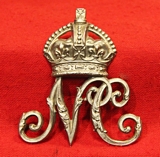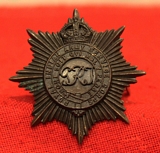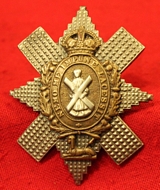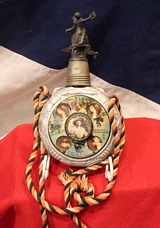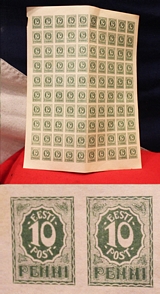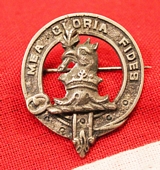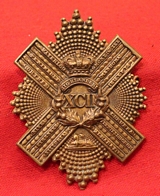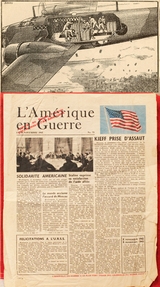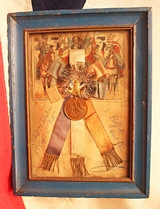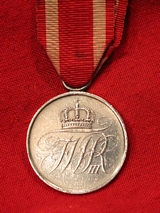Natal Carabiniers Other Ranks Helmet Plate Circa 1901-13. South Africa
Boer war period. A good die-stamped example. Crowned floreated "NC" cypher. Three loops to reverse. VGC. The Natal Carbineers participated in the invasion of Zululand in January 1879, and on 22 January, 23 members of the Regiment perished in the famous battle of Isandlwana. The unit was subsequently relegated to garrison duties at Landman?s Drift on the Mzinyathi, or Buffalo River.
South Africa, 1899?1902
Main article: Second Boer War
In September 1899, the Natal Carbineers were mobilized for active service in the British campaign to subdue the Boer republics of the Transvaal and Orange Free State. The Regiment served until October 1900, when the Natal Volunteer Forces were demobilized. Some men continued their service in the Volunteer Composite Regiment until the end of the war in May 1902.
Ladysmith, KwaZulu-Natal: From 2 November 1899 until 28 February 1900, the bulk of the Natal Carbineers was besieged in Ladysmith, and played a prominent part in that famous engagement. The most prominent military action was the attack by Colonial Forces on the Boer artillery emplacement at Gun Hill on the night of 7?8 December 1899. The Regiment lost heavily from the diseases that ravaged the garrison. A solitary squadron of the Natal Carbineers, the Estcourt-Weenen Squadron, avoided the siege of Ladysmith, and instead participated in the relief operations of Sir Redvers Buller as part of Hubert Gough's Composite Regiment. This squadron?s most notable military action of this period was the disastrous battle of Colenso on 15 December 1899, when four men were killed. These were their most serious losses for any one action during the Anglo-Boer War. Height 3 inches, width 2.75 inches read more
125.00 GBP
Royal Indian Army Service Corps Post 1921 Officer`s Cap Badge.
Part of the 7th Armoured Div. in WW2. logistical support of the Indian Army to keep the fighting forces supplied was a specialised activity over the decades and centuries. Original this was the job of the Supply Department and the Transport Departments, but these two units were merged to form the Royal Indian Army Service Corps in 1884. After Indian's independence in 1947 the RIASC became The Indian Army Service Corps. read more
45.00 GBP
Officers WW2 Glengarry Badge of the Black Watch Regt.
Very good condition, multi piece construction. During World War I the 25 battalions of Black Watch fought mainly in France and Flanders, except for the 2nd Battalion which fought in Mesopotamia and Palestine, and the 10th Battalion, which was in the Balkans. Only the 1st and 2nd battalions were regulars, with the rest either part of the Territorial Force or New Army. The Black Watch served with the British 51st (Highland) Division (World War I). Sold unpolished, for those that prefer them untouched, but it would polish very nicely indeed
Battalions of the Black Watch fought in almost every major British action in World War II, from Palestine to Normandy and as Chindits (42 and 73 columns) in Burma. In 1940, the 1st Battalion, together with two Territorial Army battalions were captured at St Valery-en-Caux with the 51st (Highland) Division, but were later reformed from reserve units of the 9th (Highland) Infantry Division, and fought at the Battle of El Alamein and the Allied invasion of Sicily. After the war, in 1948, the two regular battalions were merged into one.
The regiment won honours after the Battle of the Hook during the Korean War in November 1952, and were subsequently involved in peacekeeping and counter-insurgency in various parts of the world such as the Mau Mau Uprising and Malayan Emergency; the same activity for which the regiment was raised 250 years earlier. read more
145.00 GBP
A Most Decorative Imperial German WW1 Soldiers Schnapps Flask
This is a superb WW1 German Reservists flask (Reservistenflasche). A glass schnapps flask encased in a decorative enamelled metal jacket, with a lanyard in the black, white, and red colours of the Imperial German Reich. They were made by between 1871 and 1918, for sale to conscripts, wives or sweethearts of soldiers as a memento of their service time. The front and rear of the flask are covered in military themed vignettes, with, a military regimental panel attached to the front, and to the rear a rotating panel surrounded with picture portraits of pretty ladies. The lid is a girl and soldeir in an embrace about a WW1 fighter plane, that turns to become a drinking cup. Named for the 7th Cologne Regt. read more
395.00 GBP
A Superb Sheet of Estonian 10 Penni Stamps Issued In 1919
The first postage stamps of Estonia were issued in November 1918, just a few days after the armistice that ended World War I. Lithographed by Eduard Bergmann in Tartu. The perforated issue of the 10 p. was printed in sheets of 200, arranged in two panes of 100 each, separated by a vertical gutter. No gutter pairs are known. The 5 p. and the imperforate 10 p. were printed in sheets of 400, arranged in four panes of 100 each, separated by gutters. The printer's sheets were cut into four counter panes at the printers. Full printing sheets were distributed only during the early printing of the 5 p. For all three printings of the 5 p. the same litho stone was used. The print is imperfect and often unclear, especially for the third printing. read more
95.00 GBP
Super Scottish Clan Badge Mea Gloria Fides, Griffon Head and Coronet
Silver colour, but not hallmarked. Mea Gloria Fides, Fidelity is my glory. Possibly the Gallagher clan, the Gallagher motto is the same, this the heraldic symbol not normally a griffon. read more
45.00 GBP
British Pre- 1881 XCII 92nd Gordon Highlanders Uniform Cross Belt Badge
Plate (copper lugs) Order of the Thistle Star base with each arm of the saltire bearing three of the regiment?s battle honours, "XCII" to the centre within a thistle wreath surmounted by a crown resting on a scroll inscribed ?Highlanders?, lower section of the star bearing the sphinx on a blank tablet, very crisp detail, 71.3 mm x 95 mm, intact lugs, contact marks and light wear, very fine. read more
175.00 GBP
L'Amerique en Guerre War Airborne Psychological Warfare Leaflet Nov. 1943
No. 75. An original 4 page fold out leaflet/newspaper published by the The Psychological Warfare Division, Supreme Headquarters. Dropped by the 8th Airforce in November 1943. In the European theatre, Allied leaflet operations to the occupied countries are regarded by some as the most effective of the various leaflet campaigns. If a French citizen was found in possession of one these leaflets it could mean immediate imprisonment or even execution. Along side the single-sheet "timeless" leaflets, were news based tracts including newspapers and magazines. The largest number of leaflets was disseminated over France, simply because the country was large with a widely dispersed population. Once British forces had been withdrawn from France it became obvious that the Germans were exerting strict control of the news. If any spirit of resistance was to be kept alive, the French had to receive news and encouragement from Britain and her Allies. Great work was done by the BBC via its radio network but the likely confiscation of radio receivers by the Germans meant that some other way had to found to penetrate the Nazi propaganda wall. The ideal would have been a daily air-disseminated newspaper but this was impracticable due to a shortage of available aircraft and the unpredictability of the weather. It was decided, therefore, to institute a newspaper named Le Courrier de L'air to be dropped at weekly intervals. The first issue was dropped in December 1940 and by the time France was liberated close on 200 editions had been printed. In November 1942, the Americans designed a magazine similar to "Courrier" which was entitled L'Amerique en Guerre and was delivered by American planes until August 1944. Each of the around 100 editions stated "Brought to the French people by the U.S.A.A.F". read more
50.00 GBP
Souvenir de la Revision Classe 1905, 42nd Infantrie 8th Co. 2nd Bn
Republic Francais framed medallion with rosette and print of cavalry. Translation; Remembrance of Class 1905 revision. 42nd Infantry Regiment (42e r?giment d?infanterie or 42e RI) was an infantry regiment of the French Army, raised in 1635 as the 'R?giment de Calvisson'. It was renamed the 1638 : 'R?giment de Montpezat' in 1638 and the 'R?giment du Limousin' in 1684, before first gaining its numeral of 42 in 1791. During the First World War it was nicknamed the 'As de Carreau', since it was part of the 'Division des As' (a nickname for 14th Infantry Division). read more
75.00 GBP
A Fine Prussian Military Honour Medal In Silver 1814.
A large silver medal on its original silk ribbon. King Fredrick William III's Ehrenzeichen (honour medal). The inscription "VERDIENST UM DEN STAAT" (Meritorious Service to the State) which appears in the centre of the medal surrounded by a circular wreath of laurel leaves remained unchanged from its inception in 1814 until 1918. To better appreciate the reason why this particular decoration survived virtually unchanged as a continuous service award for subsequent Prussian kings and German Emperors after Friedrich Wilhelm III's death in 1840, to even include the retention of his initials, it may be helpful to understand the historical importance and context of his rule to the eventual founding of the German Empire.
In furtherance to this, King Frederick William III (1770-1840) succeeded to the throne of Prussia in 1797, at the age of 27, during the French Revolution. Fearful of the possible spread of democratic concepts to Prussia, he attempted to maintain a policy of strict neutrality in the political and military conflicts which were constantly taking place at that time between the new French republic and her bitter enemies in the long standing monarchies of Austria and England. Medal 1.5 inch across. Silver weight 25 grams approx. read more
110.00 GBP


